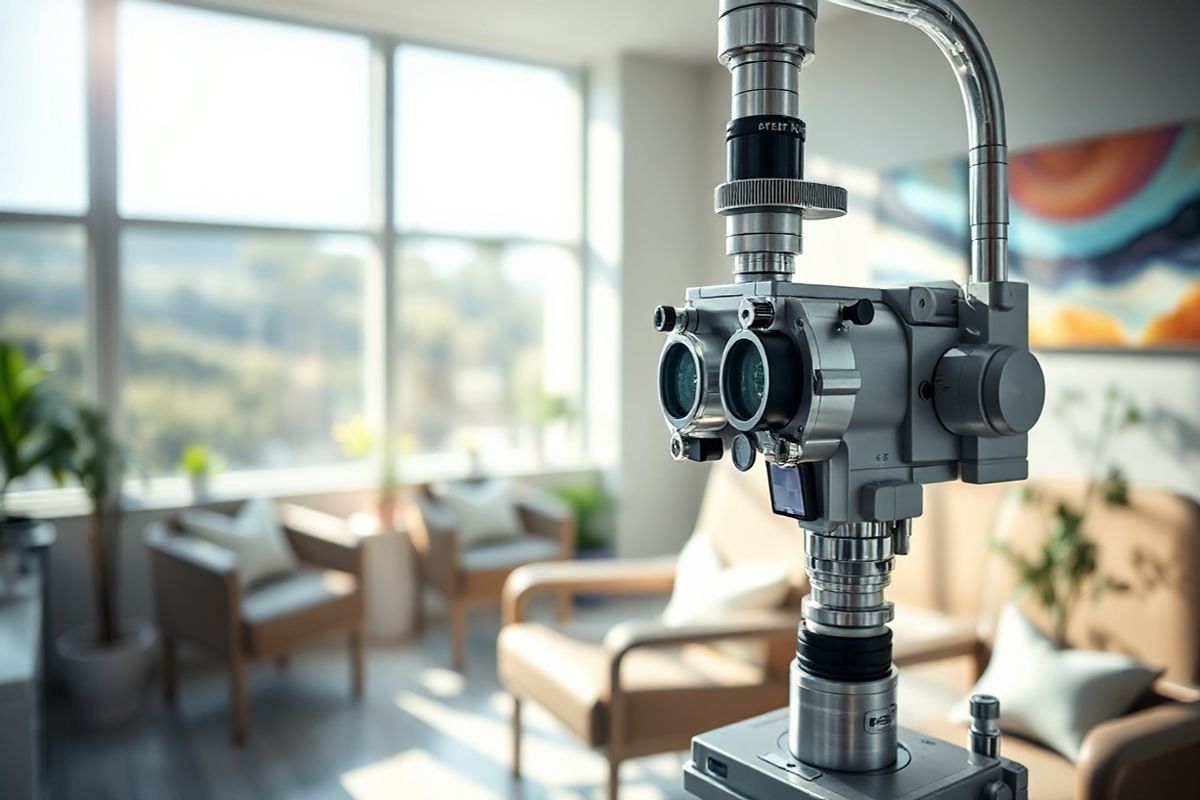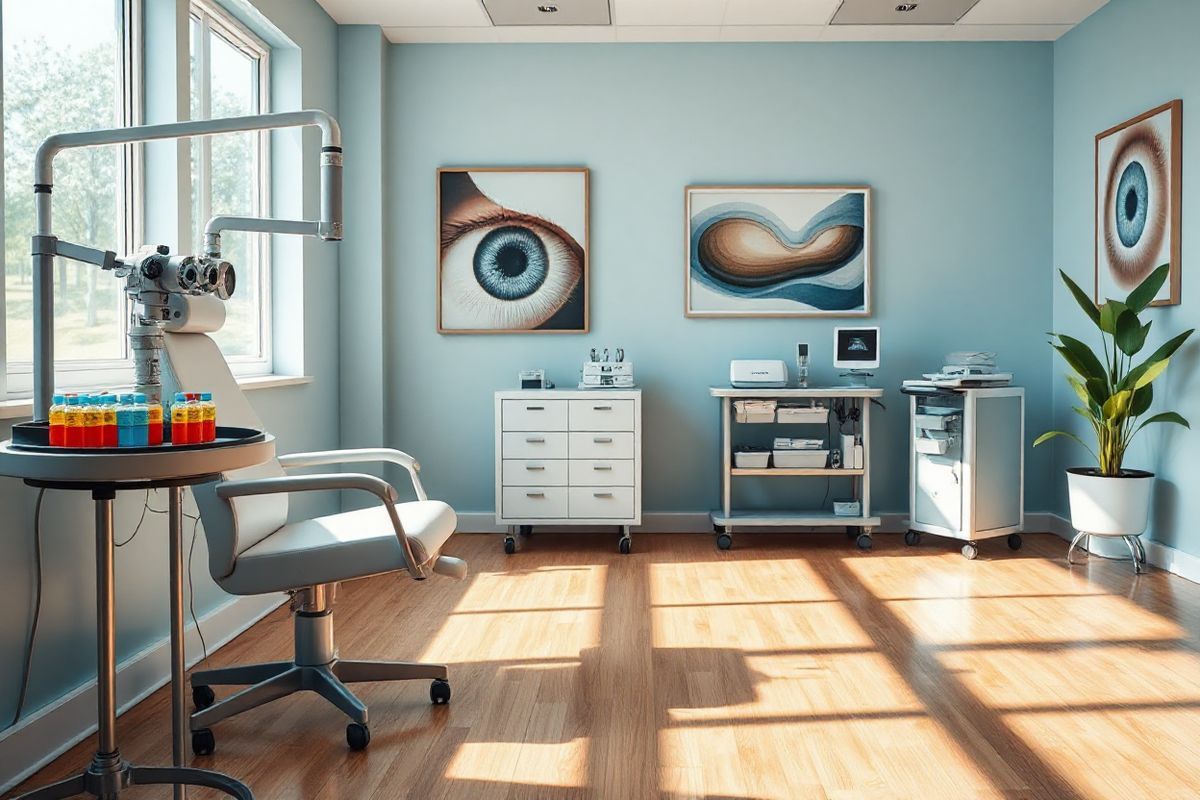Table of Contents
Understanding Posterior Subcapsular Cataracts: Causes and Symptoms

Posterior subcapsular cataracts (PSCs) are a specific type of cataract that forms at the back of the lens, right in front of the capsule that holds the lens in place. They are characterized by a rapid progression, often developing over a few months, unlike the more gradual onset seen in other cataract types. PSCs can lead to significant visual disturbances, including glare, light sensitivity, and decreased visual acuity, particularly in bright conditions (Healthline, 2024).
The formation of PSCs is associated with several risk factors, making them distinct from other cataract types such as nuclear and cortical cataracts. Key causes include:
- Diabetes Mellitus (DM): Diabetic patients exhibit a higher incidence of PSCs, attributed to metabolic changes that lead to lens opacification (Risk Factors for Cataracts in Patients with Diabetes Mellitus, 2024).
- Corticosteroid Use: Prolonged usage of corticosteroids is a well-documented risk factor, often linked to rapid cataract formation (What Is a Posterior Subcapsular Cataract?, 2024).
- Ocular Inflammation and Trauma: Conditions like uveitis and retinitis pigmentosa, along with previous trauma or surgeries, can exacerbate the development of PSCs (Posterior Subcapsular Cataract: Symptoms, Causes, & Treatment, 2023).
- Environmental Factors: Excessive exposure to UV radiation, smoking, and a poor diet may also contribute to the onset of cataracts (What Is a Posterior Subcapsular Cataract?, 2024).
Symptoms of PSCs typically include:
- Blurred or cloudy vision
- Difficulty with night vision
- Increased sensitivity to light
- Halos around lights
- Difficulty reading or performing close-up tasks
The Impact of Posterior Subcapsular Cataracts on Vision and Daily Life
The impact of PSCs on daily life can be profound. Due to the opacification of the lens, individuals often experience:
- Reduced Visual Acuity: As the cataract progresses, clarity of vision diminishes, affecting daily activities such as reading, driving, and recognizing faces.
- Glare and Halos: Patients frequently report difficulties with bright lights, particularly when driving at night, where glare from headlights can severely impair vision (Grading Posterior Subcapsular Cataract, n.d.).
- Quality of Life: The limitations imposed by declining vision can lead to decreased mobility, increased dependency on others, and a diminished quality of life, especially in older adults who may already be facing other health challenges.
A study indicated that PSCs can account for significant visual impairment in both the working-age population and the elderly, underscoring the importance of early detection and intervention (Cataract Surgery, 2024).
Exploring Effective Treatment Options for Posterior Subcapsular Cataracts
The primary treatment for PSCs is surgical intervention. Currently, there are no medical therapies available that have been proven to halt the progression of cataracts. Instead, the surgical options are as follows:
Surgical Procedures
-
Phacoemulsification: This is the most common method for cataract surgery. The surgeon uses ultrasound waves to break up the cloudy lens into small pieces, which are then suctioned out through a small incision (Cataract Surgery, 2024).
- Advantages: Minimal incision size allows for quicker recovery and less postoperative discomfort.
- Recovery Time: Most patients can return to their normal activities within a few days, although full recovery may take 2 to 6 weeks.
-
Extracapsular Cataract Extraction: In this method, a larger incision is made to remove the cataract in one piece, which may be necessary in cases of advanced cataracts (Cataract Surgery, 2024).
-
Laser-Assisted Surgery: This involves using a laser to soften the cataract before it is removed. This method can enhance precision and may further improve recovery times (Cataract Surgery, 2024).
Intraocular Lenses (IOLs)
After the removal of the cloudy lens, an artificial lens known as an intraocular lens (IOL) is typically implanted. There are several types of IOLs available:
- Monofocal IOLs: Designed to provide clear vision at one distance (either near or far).
- Multifocal IOLs: Allow for vision at multiple distances, reducing the need for glasses postoperatively.
- Toric IOLs: Correct astigmatism in addition to cataracts.
Post-Surgery Care
Post-operative care includes the use of prescribed eye drops to prevent infection and inflammation, as well as scheduled follow-up appointments to monitor recovery. Patients are advised to avoid strenuous activities and protect their eyes from bright lights until fully healed (Cataract Surgery, 2024).
The Cataract Surgery Journey: What to Expect Before, During, and After

Before Surgery
Prior to surgery, patients undergo a comprehensive eye examination that includes:
- Refraction Tests: To determine the appropriate IOL power.
- Ultrasound Measurements: To assess the structure of the eye and the shape of the cornea.
Patients may be advised to stop certain medications and start using prescribed eye drops to prepare for the surgery (Cataract Surgery, 2024).
During Surgery
Cataract surgery typically lasts about 10 to 20 minutes and is performed on an outpatient basis. The patient remains awake but sedated, and local anesthesia is used to numb the eye. The surgeon makes a small incision and uses specialized instruments to remove the cloudy lens and replace it with an IOL (Cataract removal Information, 2024).
After Surgery
Recovery from cataract surgery involves:
- Wearing an Eye Shield: To protect the eye while sleeping.
- Using Eye Drops: To reduce the risk of infection and inflammation.
- Follow-up Appointments: To ensure proper healing and address any complications.
Most patients notice an improvement in vision shortly after surgery, although some may experience temporary blurriness or light sensitivity in the days following the procedure (Cataract Surgery, 2024).
Preventive Measures and Lifestyle Adjustments to Mitigate Cataract Risks
While not all cataracts can be prevented, certain lifestyle changes may help reduce the risk of developing PSCs:
- Healthy Diet: Consuming a diet rich in antioxidants, including fruits and vegetables, may help protect against oxidative stress that contributes to cataract development.
- UV Protection: Wearing sunglasses that block UV rays can help protect the eyes from damage.
- Regular Eye Exams: Early detection of cataracts and other eye conditions can lead to timely treatment.
- Managing Health Conditions: Proper management of diabetes, hypertension, and other systemic conditions can help minimize the risk of developing cataracts (What to Know About Posterior Subcapsular Cataracts, 2024).
Frequently Asked Questions (FAQ)
What are the symptoms of a posterior subcapsular cataract?
Symptoms typically include blurred vision, light sensitivity, glare, halos around lights, and difficulty with near vision, particularly in bright conditions.
How quickly do posterior subcapsular cataracts develop?
PSCs can develop relatively quickly, often within a few months, which distinguishes them from other types of cataracts that progress more slowly.
What is the main treatment for posterior subcapsular cataracts?
The primary treatment is surgical intervention, specifically cataract surgery, which involves removing the cloudy lens and replacing it with an artificial intraocular lens (IOL).
Are there any risks associated with cataract surgery?
While cataract surgery is generally safe, potential risks include infection, bleeding, retinal detachment, and the development of posterior capsular opacification (PCO), which may require further treatment.
Can cataracts be prevented?
While not all cataracts are preventable, lifestyle changes such as a healthy diet, UV protection, and regular eye exams can help reduce risk factors associated with cataract development.
References
- Healthline. (2024). What Is a Posterior Subcapsular Cataract? Retrieved from https://www.healthline.com/health/eye-health/posterior-subcapsular-cataract
- Risk Factors for Cataracts in Patients with Diabetes Mellitus. (2024). Retrieved from https://doi.org/10.3390/jcm13237005
- Posterior Subcapsular Cataract: Symptoms, Causes, & Treatment. (2023). Retrieved from https://www.dragarwal.com/diseases-conditions/cataract/posterior-subcapsular-cataract/
- What Is a Posterior Subcapsular Cataract? (2024). Retrieved from https://www.westbocaeyecenter.com/post/what-is-a-posterior-subcapsular-cataract
- Grading Posterior Subcapsular Cataract. Retrieved from https://www.dragarwal.com/diseases-conditions/cataract/posterior-subcapsular-cataract/
- Cataract Surgery. (2024). Retrieved from https://www.hopkinsmedicine.org/health/treatment-tests-and-therapies/cataract-surgery
- Cataract removal Information. (2024). Retrieved from https://www.mountsinai.org/health-library/surgery/cataract-removal
- What to Know About Posterior Subcapsular Cataracts. (2024). Retrieved from https://www.healthline.com/health/eye-health/posterior-subcapsular-cataract











